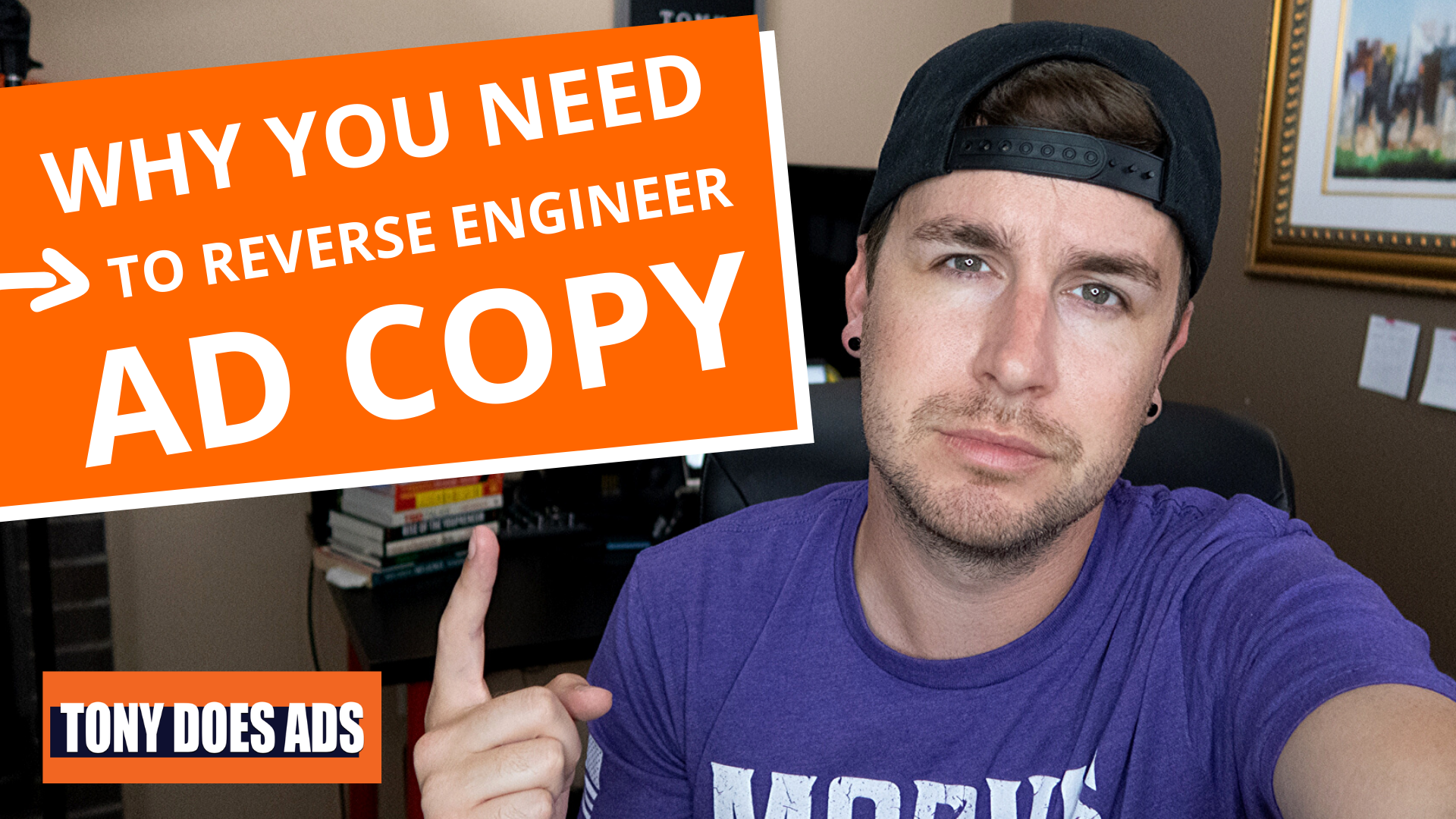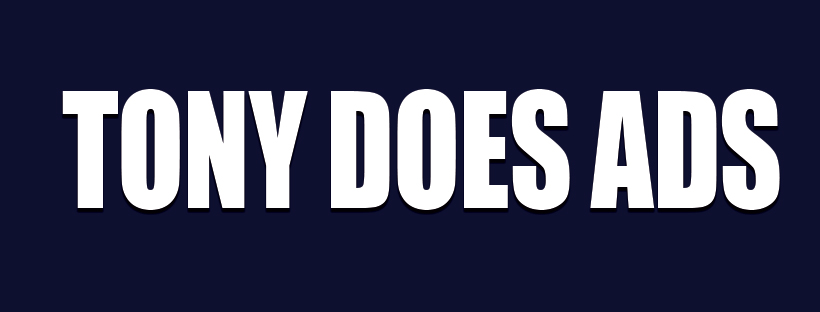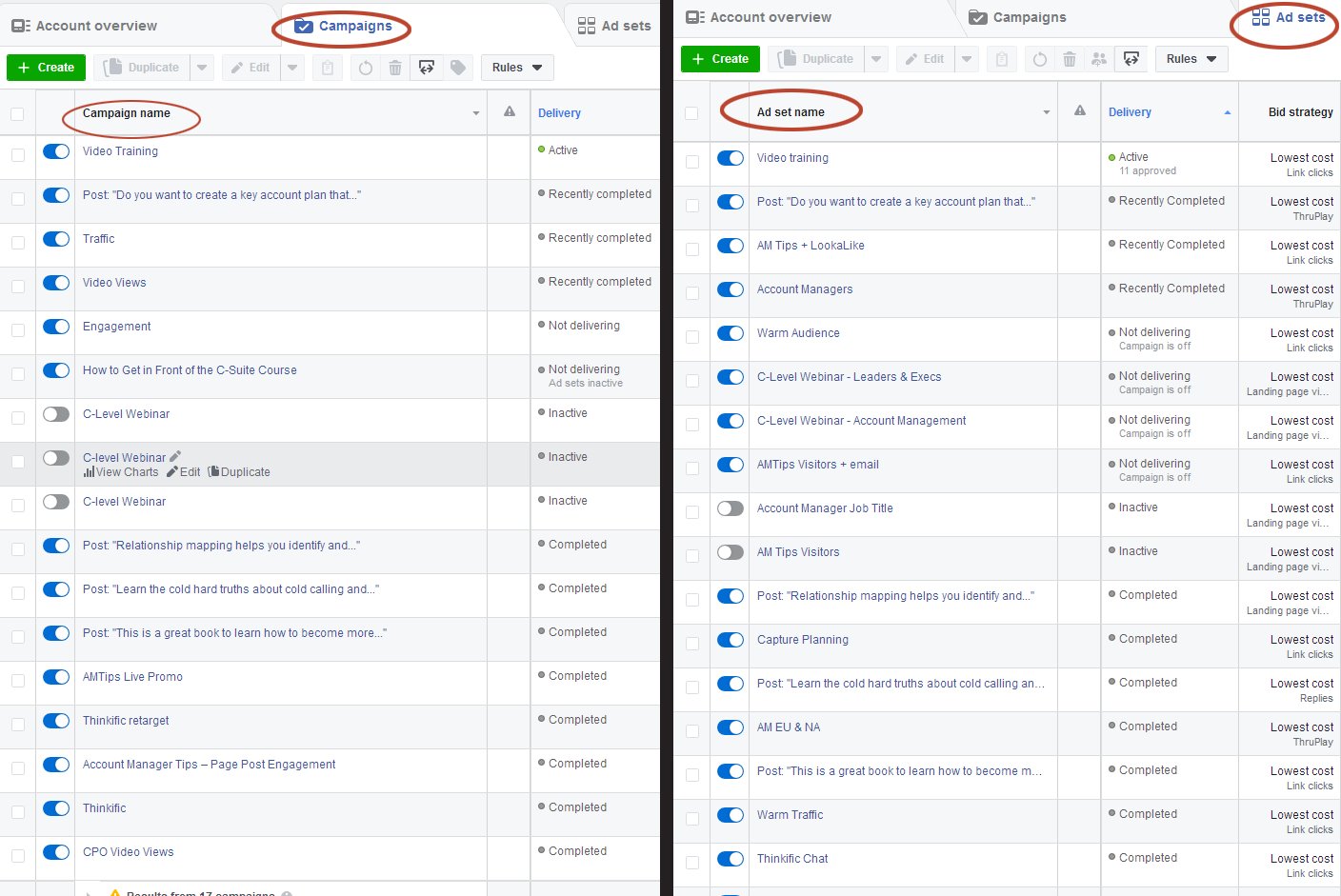
How To Name Facebook Ad Campaigns
Facebook campaigns can get messy, especially when you’ve been running multiple campaigns, ad sets and ads on accounts for a while…
Why Naming Your Facebook Ads Properly Is Important
Today we're talking all about how to name your Facebook campaigns properly.
You and your team should be able to quickly go into any ad account and know right away what campaigns, ad sets and ads are running based on naming conventions.
If you or they can’t do this, then you need a revamp!
When you get into scaling bigger and you're doing custom reports and dashboards, you definitely are going to want to make sure you have proper naming conventions that your whole team is aligned with.
Or if it's just you, you want to make sure that you can go in a year later, five months later or whatever, and still know what's going on, how your ads are being ran, who you are you targeting, etc. based on naming conventions.
The Facebook Ads Collective
Before we start, I just want to talk a little bit about where this question came from... I have a FREE Facebook group I just created and you should definitely join it for any kind of Facebook ads advice.
It’s called The Facebook Ads Collective.
Today I asked what questions people had for Facebook and Instagram advertising.
My buddy Warwick from the UK asked for some advice on how to organize and name his ad set versus his campaigns.
He said he's made a real mess of them and it is partly because of Facebook and their crappy default names.
It's definitely something that they do and it's definitely a problem. I see a lot of people having issues with their Facebook campaigns and their naming structures.
You can see just how hard it is to keep up with what you're doing, especially when you're having the amount of campaigns Warwick has here.
Without proper naming conventions your ad account can get very discombobulated.
You definitely want to make sure you have proper naming conventions, especially when you're working with a team.
I made a free handy PDF download here that you can download and use for your naming conventions. It’s a great guide, feel free to use those examples or make your own naming conventions to share with your team.
Having a guide like this is CRUCIAL to make sure your team is all on the same page. I highly recommend you create one to ensure everyone can use it as a reference going forward.
Facebook Campaign Naming Conventions
# Section of Funnel + Campaign Objective + Conversion (if selected at the Ad Set level)
For campaigns, what I do is start with the number that corresponds to the area of the funnel.
I'll add a number at the beginning where one is the top of funnel awareness, two is your consideration, which is your middle of funnel and three is your conversion, which is your bottom of funnel.
Funnel:
1 = Awareness = Top of Funnel
2 = Consideration = Middle of Funnel
3 = Conversion = Bottom of Funnel
I always do ads as a funnel (usually with a top, middle and bottom). Because I do it as a funnel, I want to know with all of the campaigns that I’m making where they lie in that funnel.
With that, I can go in and I can debug different issues that might be happening and know what area of the funnel is struggling and which area is killing it.
Facebook Ads Funnel Overview
Now just a quick overview...
The top of funnel is about awareness. It's about getting attention on your brand at that stage of the funnel.
The second part of the funnel is your consideration. That middle of funnel usually is about sending traffic to your website.
The bottom of the funnel is your conversion. This is where people are actually buying and where you're going to be doing more things like dynamic product ads and pushier ads that have bigger calls to action like buying.
Campaign Naming Convention Examples
1 - Engagement
In this first example you see a one, which means it's our top of funnel awareness campaign and we're going for engagement.
Now this is typically what we might do for various posts we’ve made. I want more people to engage with this post to see what my brand is about, so I’ve put money behind it in an engagement campaign at the top of funnel.
1 - Video Views - ThruPlay
Now the second one here is video views and it's a one because it's at the top of the funnel again, and this is where the conversion comes into place (ThruPlay in this example)…
When you go to a video view campaign, at the ad set level, (it's not on the campaign level) you'll see at the bottom what you're optimizing for.
This is what I mean by conversion.
Is it ThruPlays, 10-Second Video View or 2-Second Continuous Video Views?
Whatever you click there, you might want to have that in your naming conventions just so you know what you're optimizing for.
2 - Conversion - Add To Cart
For this next example, you see the conversion Add To Cart. This is a middle of funnel (2) conversion campaign that is being optimized for Add to Cart.
3 - Conversion - Purchase
In the next one here is a three. That means it's a bottom of funnel campaign. It's going to be one of those pushier sales type of conversion campaigns and it's optimizing for purchase.
3 - DPA
This last example is a bottom of funnel (3) campaign that is for Dynamic Product Ads (DPA).
Those are a few examples of what you might see with the naming conventions I’ve outlined in the Naming Conventions PDF.
Another addition I may tack on to the end of the naming convention is having “CBO” or “ABO” for Campaign Budget Optimization or Ad Set Budget Optimization. So you may have something like:
1 - Conversion - Purchase - CBO
Now let’s dive into how we can name Ad Sets...
Facebook Ad Set Naming Conventions
Audience Type + Targeting + Location (if needed)
For Ad Sets, I start by the audience type (Custom, Saved or Lookalike) followed by what the targeting is in a few words, and then the location if it is needed.
Custom - 30 Day FB Engagers
For this first example you can see we have engagers there, so I wrote custom because that's the type of audience it is. Then I wrote “30 Day FB Engagers” because we are targeting people that have engaged with our Facebook page in the last 30 days.
Lookalike - 1% LAL Purchasers
This next example you can see is a lookalike audience right away. This audience is comprised of a 1% lookalike of our past purchasers.
Side note: This is a great audience to target for top of funnel ads!
Saved - Marketing Interest + Parent
Now for this example we have a saved audience. I’ve added the interest target as well as the demographic for this one, so you know we are targeting parents that are also interested in marketing.
Want a cheat sheet? Get the free naming conventions PDF download here.
Now that we’ve gone over how to name Ad Sets, let’s discuss the ad level…
Facebook Ad Naming Conventions
Ad + Type of Ad + Ad Number
When it comes to your ad naming conventions, you're basically writing about what the ad is.
Perfect Pants Testimonial - Video 1
For example, the above ad is for a testimonial of perfect pants. It’s a video ad and it’s the first version of that ad.
Now, if I have more ads of the same testimonial video, I would make those video 2, video 3, etc. on the end of the name.
You want to know right away when looking at your ads what the ad is and what makes it different than the other ads you have running.
For the type of ad I put what the ad format is... a video, a carousel, an image etc.
Facebook Ads Metrics, Reports, & High-Level Views
What's cool with these naming conventions, is that I can then make reports based on if they start with a one or if they start with a two, etc. and I can group parts of the funnel together to get an overview of the funnel’s health.
This is why those naming conventions again can be very important when it comes to growing and scaling an agency with your ads.
You really want to be able to drill in and dive down into your metrics and ask, “how is our top of funnel performing? How is our middle of funnel performing? etc.”
You can do that if you have naming conventions set up properly.
I’ve used these same naming conventions to make dashboard reports in Google Data Studio:
See how easy that would be to dive into and optimize your funnel?
This is the benefit to having proper naming conventions…you’ll be able to save time and get better results for your campaigns.
Facebook Ad Naming Conventions Recap
So that was a pretty quick, pretty big overview on how we name things.
Again, if you have any questions about naming conventions feel free to comment below, DM me on Twitter, or comment in the Facebook group and I’ll be sure to help you out!
I hope you have the greatest day ever after you learned all of this!
I hope now you can go in and revamp all of your ads, so their names make sense.
It’ll save you time and open up more opportunities for better reporting and optimization.
Want the FREE Naming Conventions download?
If this blog article has been helpful, please give it a share or shout me out online!
Have questions? Comment below or tweet me!
Why You Need To Reverse Engineer Your Facebook Ad Copy
Are your Facebook ads struggling?
Is it hard for you to come up with different advertising angles for your products or services?
In this article, I’m going to break down why you need to reverse engineer your ad copy, so you can become a better writer, which will lead to a stronger community, messaging that resonates, and more sales.
What Is Reverse Engineering?
“Reverse engineering, also called back engineering, is the process by which a man-made object is deconstructed to reveal its designs, architecture, or to extract knowledge from the object; similar to scientific research, the only difference being that scientific research is about a natural phenomenon.” - Wikipedia
For the purpose of this article, reverse engineering is referring to how we can “extract knowledge” from our customers.
Now that we have the definition covered, let’s get to the source of the issue.
Why Facebook Advertising Copy Often Struggles
I have traveled to various parts of the world and have talked with hundreds of people online about their Facebook advertising.
Writing copy is one of the main issues I see business owners struggle with when it comes to Facebook advertising.
Note: If you need a basic understanding of how to structure your ads for selling your e-commerce products, check out this article I wrote for Social Media Examiner.
Why do people struggle with writing copy?
Most people I see are guessing when it comes to what sort of copy they should write.
They think they know who their avatars are and what their pain points are, but in reality, they don’t.
This is why you have to put time into researching how customers are talking about your products/services.
Pain Points + Solutions = Copy That Resonates = Sales
You need to know what specific pain points your products/services are solving.
For example, I once would go to a barbershop that was near my house... The business owner there advertised how cheap the haircuts were at his store.
The only problem was, that wasn’t the reason I was going to that barbershop.
See, I loved going to that store because I could get in and out of there very quickly.
The cuts weren’t top-notch, but I didn’t have to sit around and wait wasting time in his barbershop. I could be in and out of there in less than 30 minutes.
So if that business owner was designing new shop signs or running Facebook ads, I wouldn’t have responded to the fact that the haircuts were the cheapest around.
Instead, if that business owner was more in tune with their customers, they would know that most of them were busy professionals and just wanted a quick haircut between meetings or running errands.
This is what I see time and time again with Facebook advertising and copy.
Don’t be the business owner that doesn’t know why your customers are buying from you.
Speaking of knowing why customers buy…
Why Is User-generated Content Performing So Well In 2020?
Think of user-generated content now…
User-generated content, alternatively known as user-created content, is any form of content, such as images, videos, text, and audio, that has been posted by users on online platforms such as social media. - Wikipedia
This type of content performs so well because it’s REAL people talking about their REAL pain points.
It takes the guessing game out of creative, which is perfect!
In order to write great copy, you MUST know how your customers think about your products and how your products solve their problems.
How To Reverse Engineer Facebook Ad Copy
I’ve recently broken down the EXACT methods I use to develop solid advertising copy that converts.
I've used these techniques to help brands generate millions of dollars in sales, with Return On Ad Spends as high as 19X!
This was the exact method I used to come up with an empowering campaign that got stolen and syndicated on over 600+ news stations all over the world.
Yeah, I wasn't too happy at the time haha but you can get a sense of just how powerful this method and knowledge is.
Using the guide, you’ll learn:
How to find out how customers are thinking about your products.
How to determine your customers’ interests.
What your various customer avatars are.
What your customers’ pain points are.
How to determine what images and video you need for ads.
How to translate all of that information into Facebook ad copy that converts.
Plus, I'll show how to do this all step-by-step with real world examples!
Interested?
❌ Quit guessing how your business helps people.
❌ Quit wasting money on advertising copy that doesn’t convert.
✅ Get started with the Ultimate Guide To Writing Ad Copy That Converts today.
How To Analyze Facebook Ad Data
How should you optimize your ads over time? What KPIs should you even be looking at? One of the main things to consider when analyzing your Facebook ad data is your business goals.
In this video, we dive into how to analyze your Facebook ad data so you can see which Facebook ads you should optimize and which ads you should stop running.
I start by showing a high-level view of the Facebook ad account's health via Google Data Studio.
What Are Your Business Goals?
One of the main things to consider when analyzing your Facebook ad data is your business goals.
If your focus is on sales, the main KPIs (key performance indicators) you may want to look at are CPA (cost per acquisition) and ROAS (return on ad spend). If you are sequencing ads in a funnel, your top-of-funnel KPIs might be CPM (cost per 1,000 people viewing your ads), or impressions. Your middle-of-funnel ads you probably want to look at numbers like CPC (cost per click), or CTR (click-through rate).
When you know what your business goals are, you can make business decisions based on if your ads in your campaigns are working or if they should be killed (turned off).
Test & Optimize Your Best Performing Facebook Ads
I recommend looking at the ads that are doing the best and working to optimize them by testing more.
Try different copy, headlines, creative and even targeting to see if you can get better results over time.
You’ll also want to keep an eye on frequency rates of your ads. I recommend updating your ads every month or so to ensure they are fresh for your targeted audience.
You don’t want people getting tired of seeing the exact same ad every time.
The Facebook Ads Learning Phase
One thing to note…you won’t want to really look at your metrics and make changes to your ads during the learning phase.
When you start your ads running, Facebook tries showing them to different segments of your targeted audience to see who responds best to your ads based on your objectives.
This means, metrics and KPIs will fluctuate quite a bit until the learning phase has completed and been optimized. Wait for this phase to be done until you make any decisions on your ads and judge the KPIs.
How To Adjust Ads Over Time?
So how does one even optimize and adjust ads over time?
It’s really not that complicated…Most of the time it involves shifting the budgets around in the funnel (moving spend up higher from bottom-of-funnel/middle-of-funnel to top-of-funnel to grow your audiences).
Facebook is changing to Campaign Budget Optimization, so most of this work will end up going away (hopefully if CBO works well).
You also want to look at your ads and see if they are hitting your business goals. If they are struggling kill the ads. If they are performing well, test and optimize those puppies!
Questions?
Let me know below!







